

Brand isn’t just a logo or tagline – it impacts a company’s search performance and competitive edge.
Brand identity influences how search engines rank your content and how your audience searches for and engages with your brand.
This rundown isn’t just about why brand matters – it’s about how to leverage it at every level, from SEO strategy to interactive content that drives real connections.
For teams juggling integrated search strategies, this collection cuts through the noise and shows how to build brand experiences that don’t just rank – they resonate.
We especially think you’ll like “Four Reasons You Can’t Ignore Branded SEO in 2025,” which explains how to turn branded search into a competitive advantage. Learn to use SEO data and multi-channel strategies to boost visibility, engagement, and long-term business impact.
Let’s get to work building a brand that wins.

Katie Morton Editor in Chief, Search Engine Journal
Four Reasons You Can’t Ignore Branded SEO in 2025
Learn about why brand will matter so much in 2025 and how educating users and search engines about your brand can increase traffic.
 Darrell Mordecai
Darrell Mordecai

This post was sponsored by Similarweb. The opinions expressed in this article are the sponsor’s own.
According to Rand Fishkin:
‘For most small and medium businesses and newer creators/publishers, SEO is likely to show poor results until you’ve established credibility, navigational demand, and a strong reputation among a sizable audience.’
In other words, if you want to build organic traffic, build your brand.
The question is how do search engines measure brand, and what does that mean to your SEO?
In this post, I’ll dig into what influence SEOs have over brand-building, and show you:
- Why branded SEO is an untapped opportunity you should grab with both hands.
- How brand in SEO differs from traditional brand strategy.
- Ways you can educate Google about your brand.
Branded SEO, An Untapped Opportunity
Branded SEO remains a largely untapped SEO opportunity. It’s untapped because, as SEOs, we’re trained to ignore branded traffic. However, by ignoring branded search, you are potentially missing some big opportunities to move your business forward.
The reason is that users don’t just use search engines to discover information and products. They also use search engines to discover brands. By focusing on how your brand shows up, you have an opportunity to influence how middle-of-the-funnel users perceive your brand. If you get it right, that could turn into a long-term relationship with your brand. Get it wrong, and I’m sure you have a number of competitors that would love to have the business.
This leads us to a crucial question…
Is There An SEO Angle To Brand?
As SEOs, we influence how content appears on search engines. The function of a search engine is to match end users with content. This means as SEOs, we are not just dealing with how users perceive your brand. We are dealing with how search engines understand how users perceive your brand.
The difference is not subtle.
Search engine algorithms measure how strong a brand is and incorporate those signals into the search results. They primarily seem to use three methods:
- Measuring branded search queries
- Measuring brand engagement metrics
- Understanding your brand entity
So, if the search engine incorporates brand signals into how it generates search results, then as SEOs we should be looking for a strategic way to influence these signals.
1. Branded Search Queries
Google’s leaked documents reveal a crucial aspect of branded SEO: the strength of a brand significantly influences its search rankings. This is measured through what we can call the BrandQueryFactor. This metric assesses how frequently users search for a brand by name. The more brand-specific queries a company receives, the higher its likelihood of ranking well in search results.
We understand that branded searches affect your rankings, the question now is, in what way do they affect your rankings?
Perhaps the answer can be found in a Google patent called Ranking Search Results. This patent describes how Google uses branded search queries as a quality factor similar to links. In fact, it describes branded and navigational queries as implied links that demonstrate user trust and intent.
These ‘implied links’ have a slightly different role in establishing a site’s authority than actual links:
- Links act as a vote of confidence from other websites, often indicating external recognition or authority
- Branded queries reflect real-world user interest, signaling how often users search for and interact with a resource through queries
Putting that together with the Google leak metrics above, we see that brand signals include user engagement and branded query analysis. Google uses these signals to see how users engage with your brand.
Increasing brand signals with branded queries and direct traffic
As an SEO can you increase branded traffic? The sad truth is, not directly. When your SEO starts to bring in traffic you will see an increase in branded searches. But this is an indirect benefit rather than a branded search strategy.
Does this mean branded search is out of your hands?
To answer this, it’s important to first understand how to increase brand signals.
A few years ago, when I worked as an SEO manager, I noticed something. Whenever we ran PPC campaigns, we would see increasing amounts of branded search terms in our Search Console accounts.
The reason is pretty simple. People saw our ads and Googled the brand name. Take a look at the Similarweb Channels report below. What do you see? (Hint, the blue line represents organic traffic.)
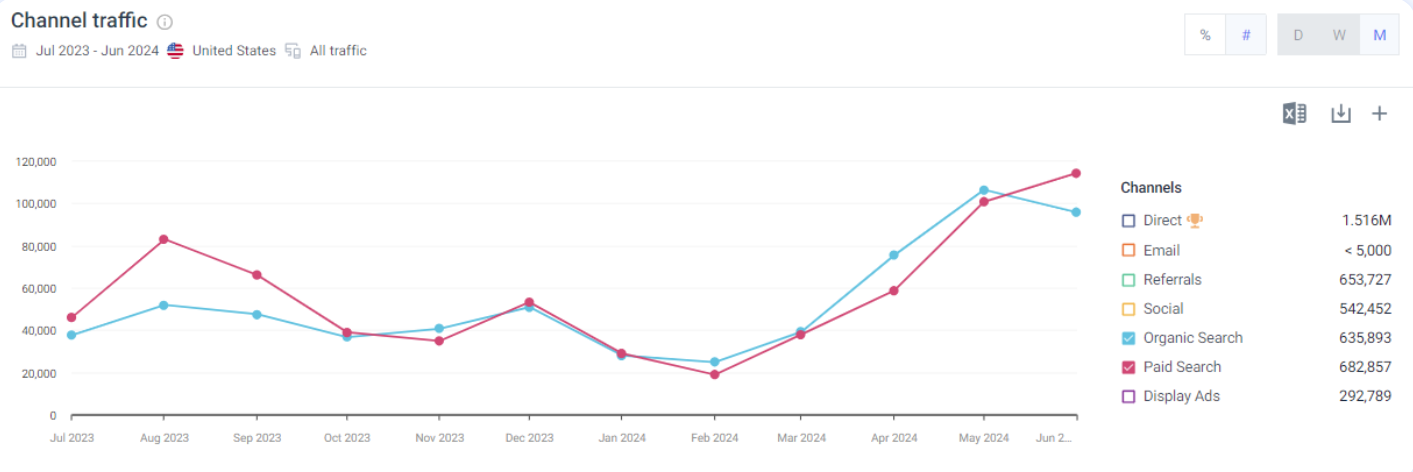 Screenshot from Similarweb, September 2024
Screenshot from Similarweb, September 2024
Channel data for greenies.com
As we see above, organic traffic seems to correlate directly with paid search.
 Screenshot from Similarweb, September 2024
Screenshot from Similarweb, September 2024
Looking at the organic search breakdown for the brand in 2023, we see that 72% of the site’s keywords were branded.
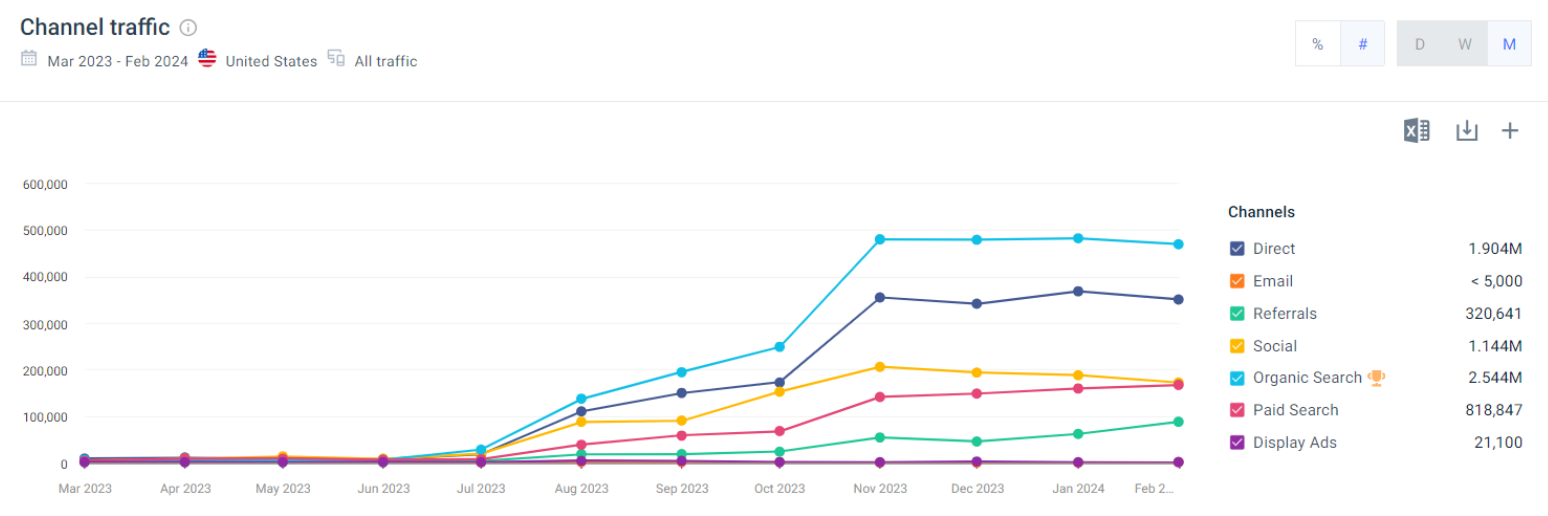 Screenshot from Similarweb, September 2024
Screenshot from Similarweb, September 2024
Channel data for elorea.com
What we see above is organic traffic directly correlates with other channels.
 Screenshot from Similarweb, September 2024
Screenshot from Similarweb, September 2024
Looking at the organic search breakdown for the brand in 2023, we see that 81% of the site’s keywords were branded.
The reason for this pattern is that the more your audience sees your brand, the more likely they are to Google your brand.
Another great example of this is monday.com. The brand has doubled down on its brand strategy, focusing primarily on YouTube ads.
 Screenshot from Similarweb, September 2024
Screenshot from Similarweb, September 2024
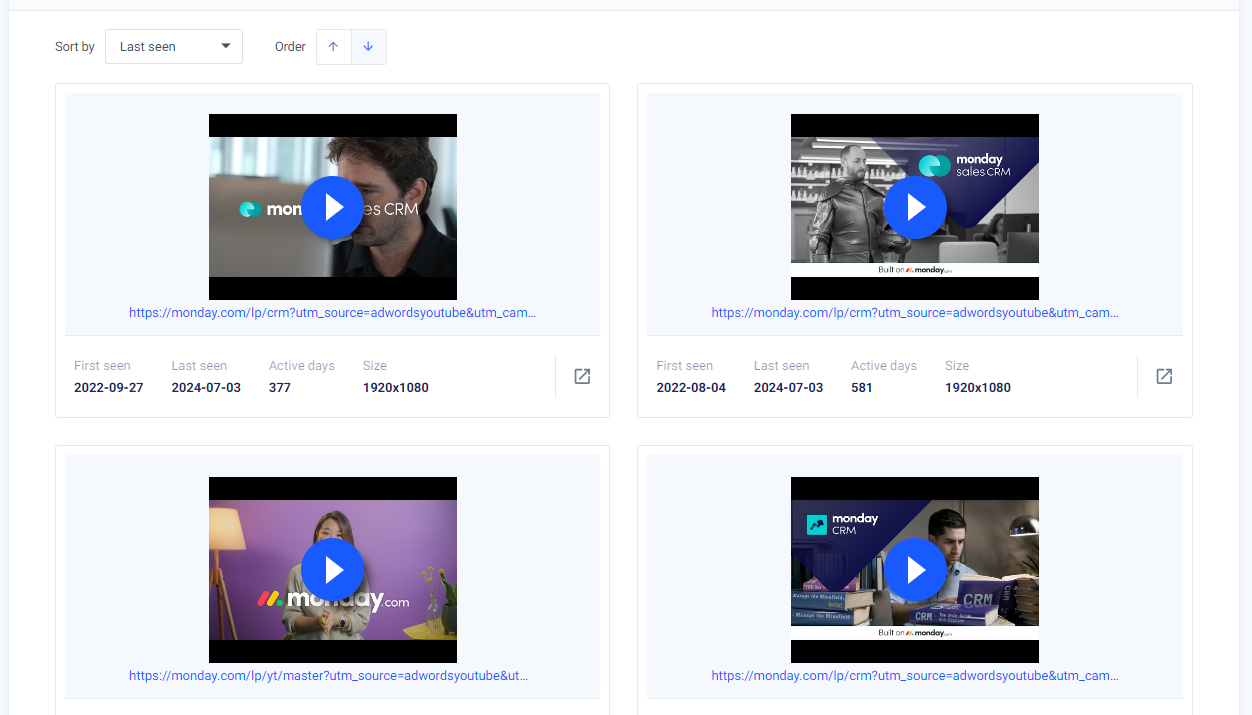
Its YouTube ads together with its memorable domain name has led to unprecedented levels of direct traffic.
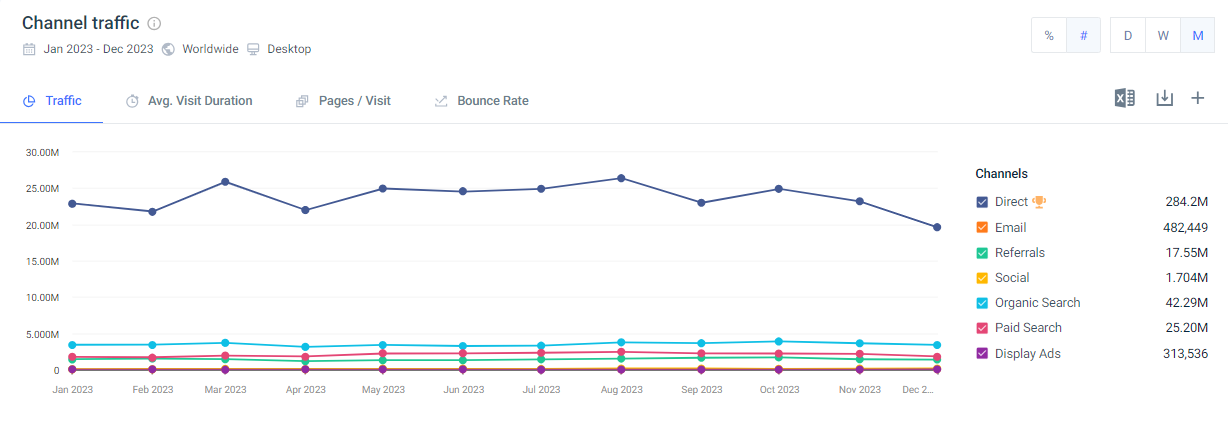 Screenshot from Similarweb, September 2024
Screenshot from Similarweb, September 2024
Although I haven’t yet seen evidence that Google uses direct traffic as a ranking signal, it stands to reason that it does. What’s more, you can see that Google has taken notice of the brand.
Try Googling the word Monday and then Google the word Tuesday and compare the results. To Google the word Monday refers to a brand.
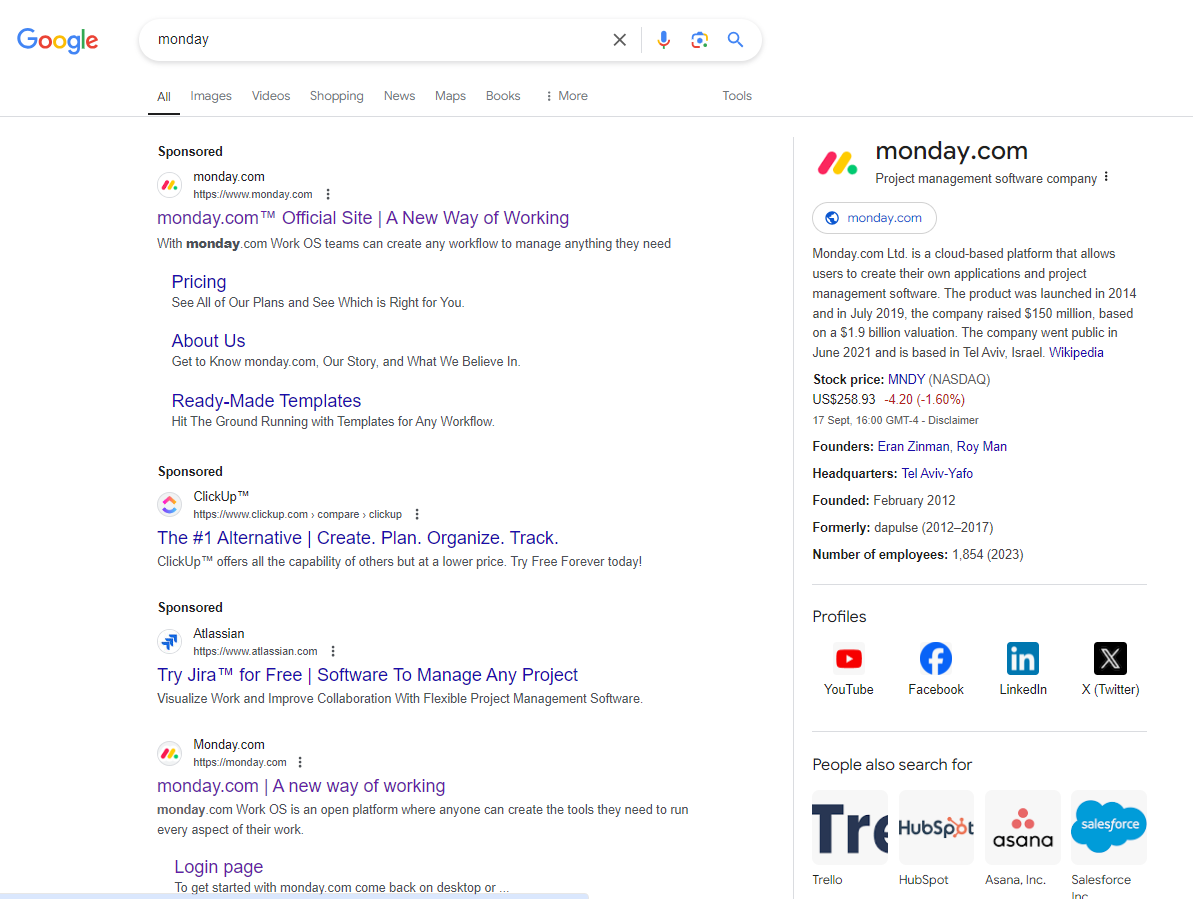 Screenshot from search for Monday, Google, September 2024
Screenshot from search for Monday, Google, September 2024
Tuesday, on the other hand, is a day of the week.
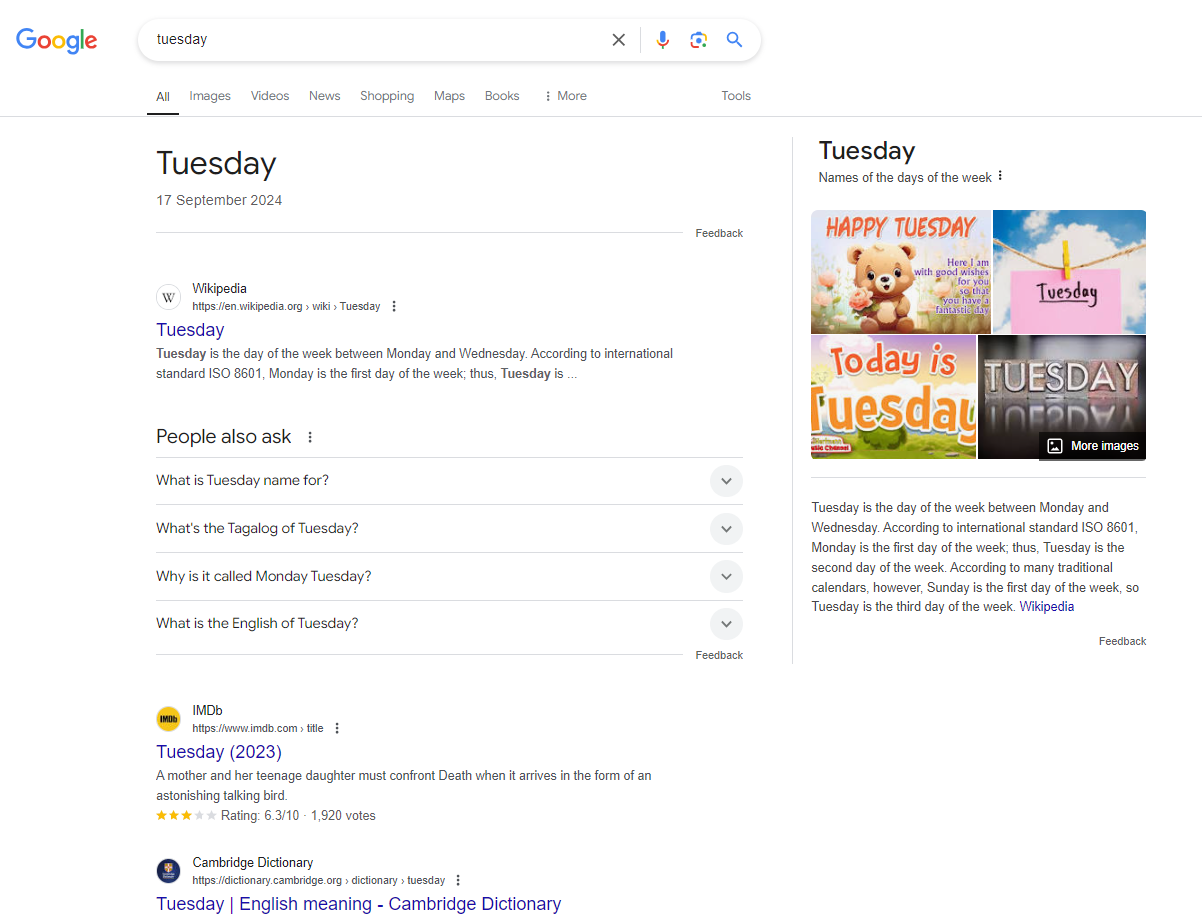 Screenshot from search for Tuesday, Google, September 2024
Screenshot from search for Tuesday, Google, September 2024
The takeaway: You can increase brand signals like branded keywords and direct traffic by focusing on other channels.
So where does this leave you as an SEO?
You have the data to assess branded keywords and direct traffic, putting you in a unique position to partner with marketing leaders to work on big-picture marketing strategies designed to increase branded keywords.
2. Brand Engagement Metrics
Looking at the Google leak we can also see that Google measures user engagement as a signal of brand strength.
Brand Engagement Metrics includes user engagement factors such as click-through rates (CTR) and user interactions with the brand’s content. Higher engagement can positively influence rankings.
This means focusing on improving user engagement is a crucial aspect of brand SEO.
The best way to evaluate user engagement on your site is to compare your engagement metrics with that of your competitors.
For instance I’m analyzing toyota.com and four of its competitors with the Similarweb Website Performance report. Looking at the Engagement metrics we see that ford.com is getting more engagement in almost all metrics.
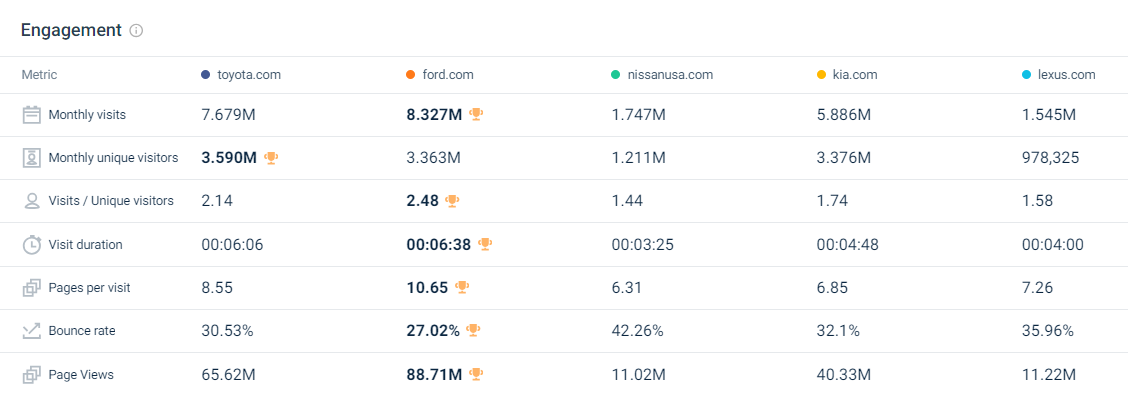 Screenshot from Similarweb, September 2024
Screenshot from Similarweb, September 2024
One of the best ways to improve user engagement is to focus on site navigation. This means figuring out the flow of information on your site and including it in your:
- URL structure
- Bread crumbs
- Top level menu
Also make sure that the top of the fold section of every piece of content directly answers the user intent directly.
3. Creating content For [Brand] + Modifier Keywords
You have direct influence over how your brand appears when users search for it on Google. While you might assume all your branded traffic goes to your homepage, there are actually other ways to capture this traffic.
What’s more, your branded traffic can help you discover customer sticking points or even areas where you are potentially losing customers to your competitors.
Want to see how? Try digging through your branded keywords. You are looking for keyword modifiers that either represent issues to resolve or opportunities to be won.
Keyword modifiers might be:
- [brand] pricing
- [brand] reviews
- [brand] alternative
- Where is [brand] located
- [brand] alternative
By looking through your branded keywords, you can quickly see how users are interacting with your brand by seeing the questions they are asking. Make sure you have content that answers all of these questions. If you find long-tail queries it might be a good idea to create an FAQ on your site.
If you don’t do this you might see your branded traffic go to sites like YouTube or worse, your competitors.
For instance using the Similarweb SERP Players report below, we see a large portion of branded clicks for Ninja Creamy going to YouTube.
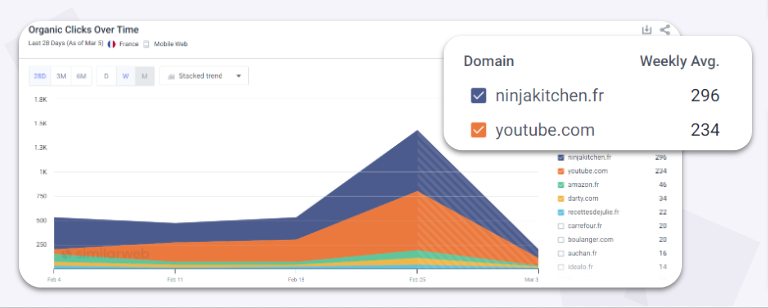 Screenshot from Similarweb, September 2024
Screenshot from Similarweb, September 2024
What’s fascinating about this is that YouTube is not above the fold. This means that users often have more than one search intent and are willing to scroll to find what they are looking for. Can you afford to lose traffic for YouTube?
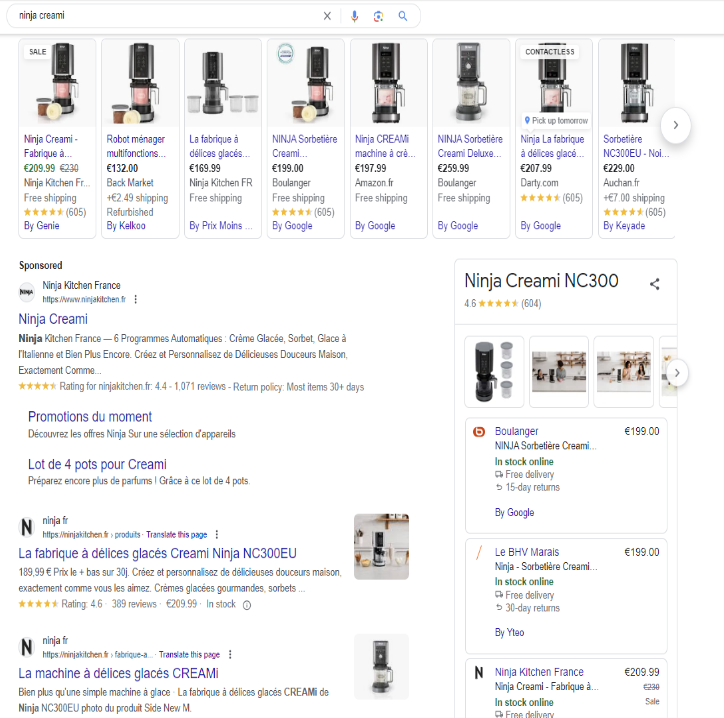 Screenshot from search for Ninja Creami, Google, September 2024
Screenshot from search for Ninja Creami, Google, September 2024
In a case like this depending on which videos users are clicking on, it might make sense for the brand to create video content designed to feature on the SERP.
A great example of a brand that got this right is wildgrain.com. In 2023, the keyword ‘wildgrain reviews’ was trending. Fortunately for the brand they already included a page on their site featuring reviews.
Googling the keyword, users were faced with Wildgrain’s own reviews page ranking in position #1. What’s more the rich result included a review rating of 4.7 out of five. It also listed the amount of reviews (which currently stands at 31040.)
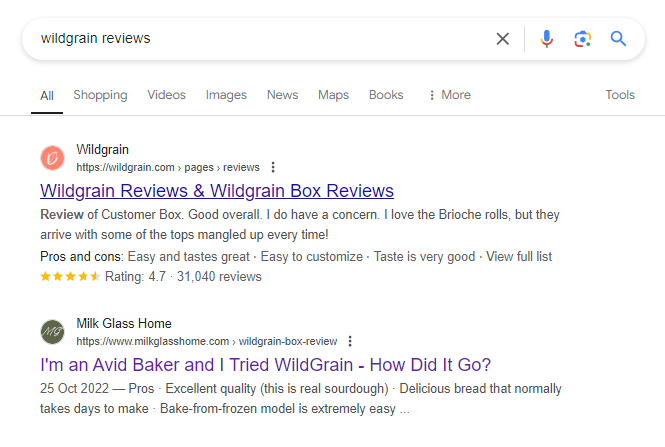 Screenshot from search for Wildgrain reviews, Google, September 2024
Screenshot from search for Wildgrain reviews, Google, September 2024
Our data shows that 72% of searches were zero-click. That means the vast majority of users were satisfied with what they saw in the search results.
What’s interesting is of the remaining 28% of users, 57% clicked on the Wildgrain’s own result.
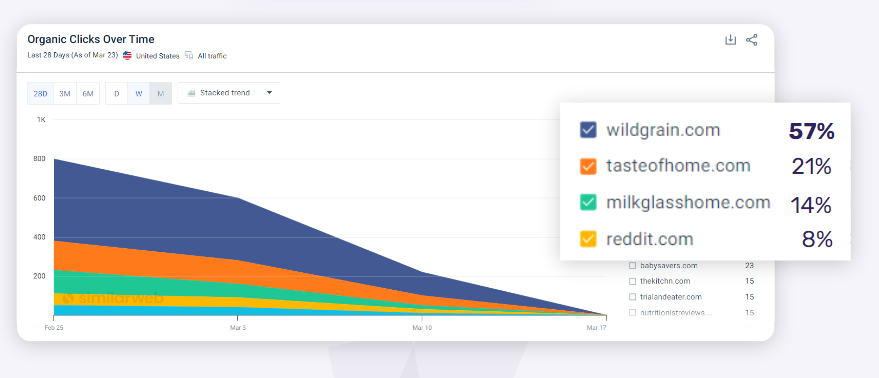 Screenshot from Similarweb, September 2024
Screenshot from Similarweb, September 2024
The takeaway is with the right content, you can directly influence how users interact with your brand, even on things like reviews.
4. Educating Search Engines About Your Brand Entity
Another aspect of how Google evaluates your brand is through your brand entity. Google’s machine learning allows the search engine to understand real-world entities. It does this by gathering information about entities mentioned around the web and arranging that information in a similar way to how a human brain arranges information.
The purpose of this is to understand the relationships between people, places, and things so that Google can deliver more relevant and contextual information in the SERPs.
Google’s knowledge is constantly expanding and updating as new information becomes available.
How does Google understand your brand?
To find out, just Google it. If there are strong signals around the web, Google will present you with things like a Knowledge Panel, Twitter (X) boxes, image boxes and more.
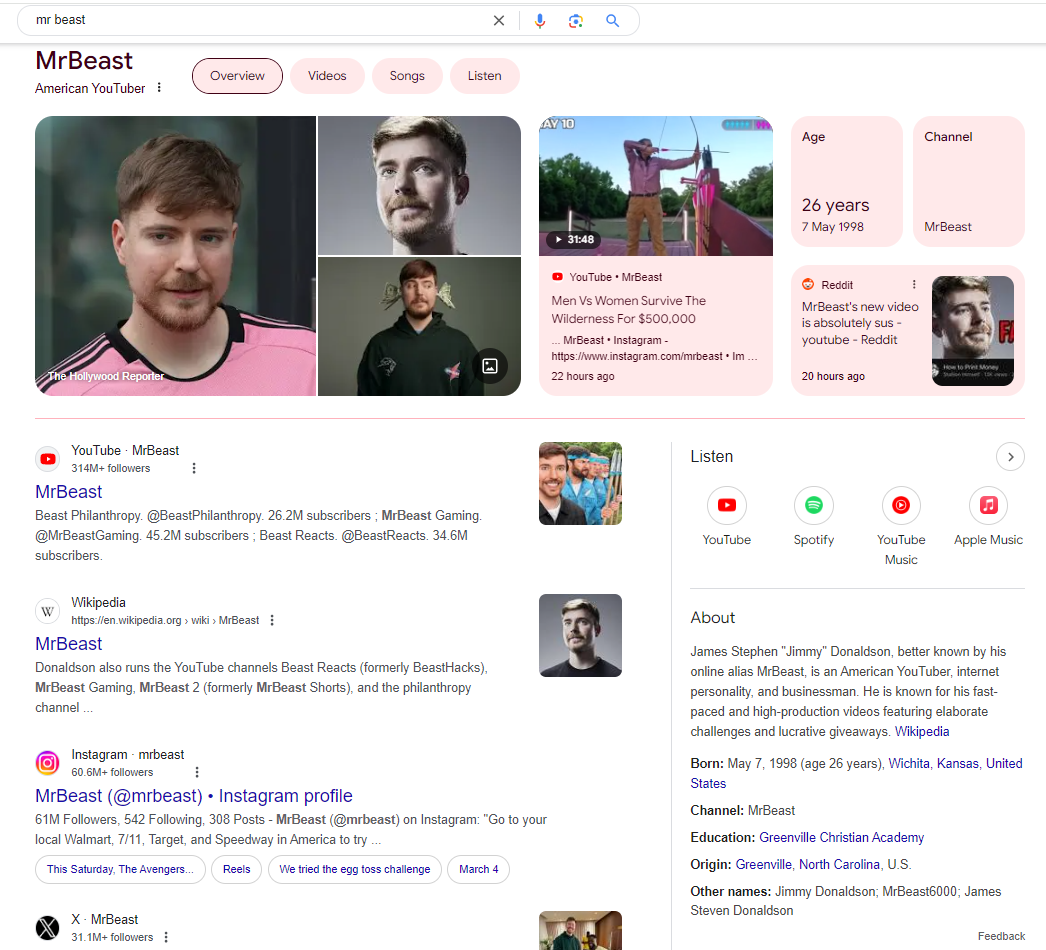 Screenshot from search for Mr Beast, Google, September 2024
Screenshot from search for Mr Beast, Google, September 2024
If you don’t see anything, you have work to do, as I mentioned above, a large portion of users hear about your brand and then Google you. What they see when they arrive on your brand SERP is up to you.
The great news is you can educate Google about your brand entity. When you do that, you’ll not only improve your brand SERP, but you might see your brand popping up in other strategic places.
For instance, below, I’ve searched for Fandango, a company that sells movie tickets. If you look at the bottom of the Knowledge Panel on the right, you’ll see Fandango’s direct competitors including:
- AMC Theatres
- Regal Cinemas
- Cinemark Theatres
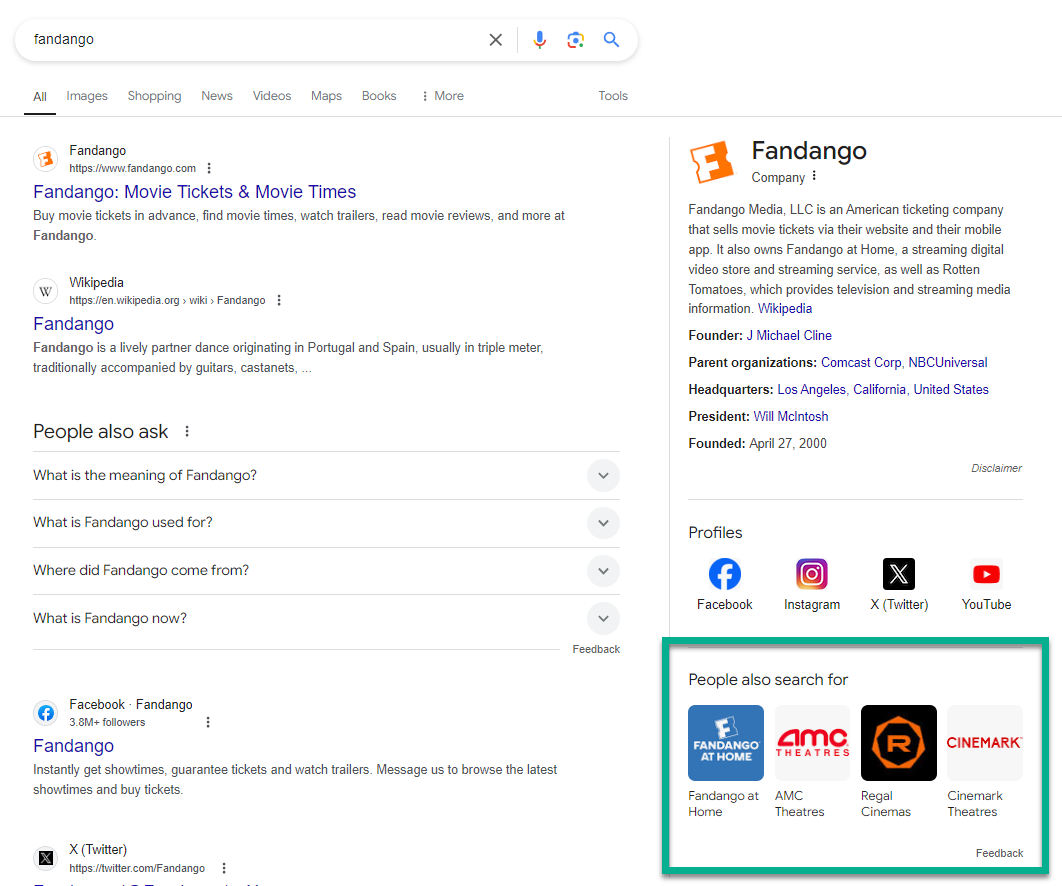 Screenshot from search for Fandango, Google, September 2024
Screenshot from search for Fandango, Google, September 2024
How did a site’s competitors make it into the site’s Knowledge Panel? Google doesn’t only rank content for keywords any more. It understands what the brand entity is and what it relates to. The result is you might find your brand mentioned appearing on your competitor’s brand SERP or in other relevant places on the web.
How do you educate Google about your brand entity?
There is a clear method to educate Google about your brand entity.
- Establish an entity home page: Create a dedicated page that describes your entity. This page should clearly outline what your business does and who it serves. Although this can be any page on the web, the best place to do this is on your ‘About Us’ page.
- Build entity citations: Mentions of your brand across the web will reinforce the information provided on your brand homepage. It’s important to keep your brand description consistent around the web so that Google can match each citation with your entity’s home page. Citations can appear on pages you control, such as social media profiles but citations on pages you don’t control often carry more weight and provide the most benefit.
- Link from your entity homepage to your entity citations: This could mean including links to your social media profiles as well as any guest posts, videos, or podcasts your brand is featured on.
Far From The Final Word On Brand SEO
As an SEO, if you prioritize branded SEO, you are not just a technical specialist. You have access to data to shape the business’s digital identity, which can drive tangible and sometimes immediate results. This paradigm shift allows you to directly impact revenue streams, aligning SEO efforts more closely with overarching business objectives.
If branded SEO is a paradigm shift for you, consider this.
Branded SEO is only one ranking factor in Google’s complex maze of ranking systems. You can read more about it in our latest ebook: Google’s Ranking Anatomy: Dissecting 90+ Ranking Signals.

Why You Should Be Focusing On Brand Marketing Right Now
Uncover the importance of brand marketing in today's search landscape. Find out why focusing on conversational content can have a positive impact on your brand.
 Mordy Oberstein
12K Reads
Mordy Oberstein
12K Reads

If you’ve been paying attention to the chatter in the SEO space recently, you might have noticed that “brand marketing” has become cool again.
Due to the Google “leaks,” many SEO pros have come to the conclusion that building a strong digital presence will yield SEO results.
Also, water … is wet.
Leaks, floods, and drips aside, there are better reasons why you should be focused on brand marketing right now.
Allow me to explain. [Warning: This post contains excessive amounts of snark.]
Building The Case For Brand Marketing
I’m not going to do the whole “5 reasons why you should focus on brand in 2024.” It would be off-brand for me.
What I would like to do, if you’ll indulge me, is first build up the case by looking at where the ecosystem we call the web is currently at.
I’m less focused on “the benefits” of the brand and more concerned about why the ecosystem itself demands a focus on this type of marketing.
It’s less a matter of “you’ll get X, Y, and Z” by focusing on the brand and more a matter of why you’ll be out of sync with your potential audience as a whole.
The Web Is Moving To Be More Conversational
The internet has become more conversational, and it’s only going to get more conversational.
One of my soapbox points is that content is one of the most quickly changing things on the planet. What we consume, how we consume it, and what we expect out of it are rapidly and constantly changing, and the consequences are often underappreciated.
My classic example of this was the first televised US presidential debate, which took place in 1960 and pitted John F. Kennedy against Richard Nixon.
If you listened to the debate on the radio, you tended to think Nixon won. Those who watched on TV tended to think JFK won.
Why? Well, Richard Nixon comes off as Richard Nixon, and JFK, well looks like JFK. I’m being a bit facetious, but it is true. Nixon famously looked pale, had a five o’clock shadow, and didn’t look directly at the camera.
The evolution of content has extremely understated consequences.
Like in 1960, we are at one of those pivotal moments in the history of content.
Think of the internet like TV commercials. Over time, what once resonated becomes campy and sem, if not downright, spammy.
Could you imagine Coca-Cola running and trying to sell its product using its 1980s Max Headroom “Catch the Wave” commercial?
Try selling my kids a sugar-infused breakfast cereal using a TV commercial from the 1950s. Good luck.
It’s not because those commercials are “bad.” It’s because the language and tone that resonates changes over time.
It’s a simple enough point … unless we’re talking about web content. For some reason, we feel web content and its consumption trends should eternally stay the same.
We write the same kind of content in pretty much the same way and balk at any changes.
But that doesn’t change the reality.
The content we create doesn’t speak to users. It’s not positioned correctly. The tone is off. The goals that support the creation of content, to begin with, are distorted. And more. There are a lot of problems – and to me, they all begin with content not being conversational.
In fact, I will go so far as to say Google should stop saying, “Write for your users,” and should start saying, “Have conversations with your users.”
We all think we’re “writing for our users” – I mean, who else are we trying to lure and convert?
It’s very easy to fool yourself into thinking you are “writing for your users.” It’s harder to convince yourself you are having some sort of dialogue with your users – which is what I think Google really means anyway.
All this said, what do I mean by content not being conversational and how do I know it’s even a problem?
What I Mean By Content Not Being Conversational
It’s not hard to see that we are not engaging our users in a conversation or dialogue.
All you need to do is head over to your nearest landing page and have a look at the language.
How much of it is just the company throwing out jargon or borderline nonsense?
Here’s what I came across in literally less than five minutes of digging around:
 Screenshot from author, July 2024
Screenshot from author, July 2024
Is it really without limits? Can I literally do whatever I want without any limitations whatsoever? I don’t get it – are we talking about God or graphic design software?
Is the below really a new way to run high-velocity sales? Does it literally refine the entire process like no one else is doing or has done before? Or is the company just saying this and spitting out whatever they think will drive conversions?
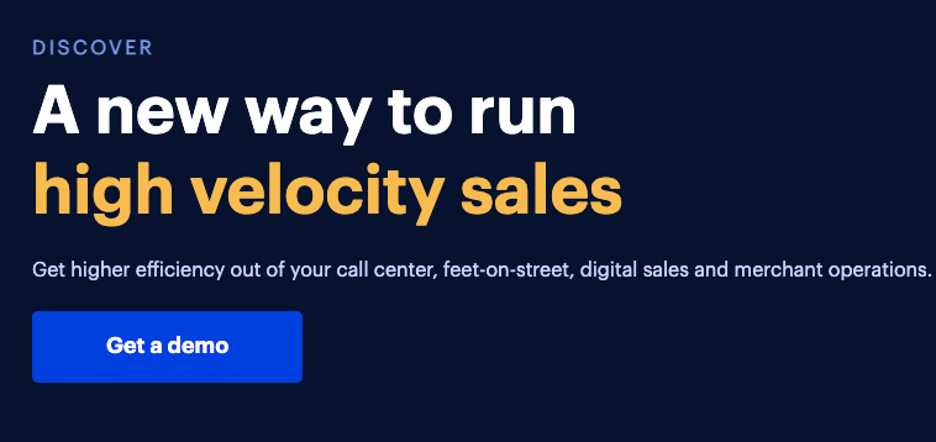 Screenshot from author, July 2024
Screenshot from author, July 2024
You see this all the time in PPC ads:
 Screenshot from search for [buy accounting software], Google, July 2024
Screenshot from search for [buy accounting software], Google, July 2024
No nuance. It is the best accounting software, and I should trust that it is without any form of qualification.
This kind of copy, while it may have worked in the past, doesn’t (and if it does now, it won’t in the relatively near future).
This kind doesn’t actually talk to users in a real way. It actually treats the user like an idiot.
The average web user is far more savvy than they once were, far more mature, and far more skeptical.
Not taking a more genuine approach is starting to catch up with brands.
How Do I Know Not Being Conversational Is Even A Problem?
Greenwashing.
It’s when a company claims to be more environmentally conscious than it is. It’s spin and PR nonsense.
Companies thought they could pull a fast one on unsuspecting users. However, folks are now savvier and are catching on to brands positioning themselves as being “green” when, in reality, they might not be (or at least to the extent advertised).
You cannot get away with it anymore (and you never should have tried). The only thing that works is being genuine.
If your product is not actually “the best,” then don’t say it is – or, in fact, realize there is no “best” or “ultimate” or “fastest” or whatever. There is only what meets the needs of users in what way. That’s fancy talk for “pain points.”
Being genuine means talking to your audience and not at your audience. It’s having a dialogue with them.
Going the “traditional” route with your language is the equivalent of marketing language greenwashing … and it applies to your informational content, too.
Perhaps nothing epitomizes this more than the falling stock of influencer marketing. Study after study shows that younger users are far less likely to purchase something because an influencer is associated with it.
Influencer marketing, as we mostly know it, is a facade pretending it’s not a facade. Do you think Patrick Mahomes really eats Chicken McNuggets or has a strong preference to use State Farm for his insurance needs?
All influencer marketing is just a digital marketing version of a celebrity in a TV commercial.
Do you think whatever TikTok influencer really prefers Capital One or even knows that it’s not a geographical reference?
While the idea of “influencers” seemed like a viable idea at the onset it’s fundamentally not sustainable because it’s fundamentally fraudulent. (For the record, “community” marketing is something else entirely. While it might rely on “influencers” within a community, it is far more genuine.)
It seems that folks have caught on to the idea that maybe this influencer being paid to say or do whatever is not actually an accurate reflection of reality (much like social media influencers themselves, to be honest).
A 2023 Drum article quotes one study as saying upwards of 80% of users say a brand’s use of influencers does not impact them one way or the other.
For the record, there are other studies that indicate that influencer marketing is a viable option. I agree, but I think it needs to be qualified. Just paying an influencer to say good things about your brand is not authentic.
There are authentic ways to work with communities and influential folks within them. That tends to happen more with micro or nano influencers.
This is why we’re seeing a trend towards working with micro or nano influencers who might provide a more authentic experience for audiences – a trend noticed by Hubbspot’s 2024 social media marketing report (among others).
Again, it’s rocket science. Everyone knows the influencer is only saying the things they are saying because they’re being paid to. It’s relatively meaningless in a vast majority of cases.
It shows how much savvier the current web user is relative to the past, and it’s supported by where folks are heading and what they are trusting … themselves (DTA, am I right?).
A seemingly endless number of studies show users looking toward user-generated content. CNBC was quoted as saying, “61% of Gen Z prefer user-generated content.”
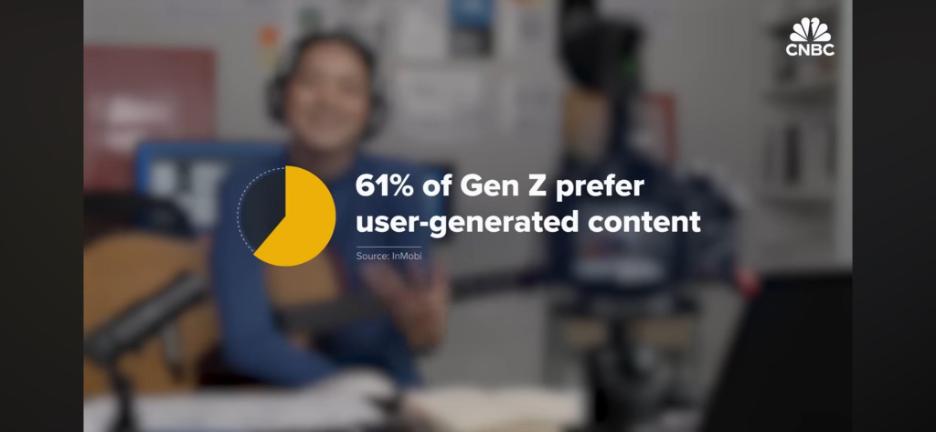 Image from CNBC, July 2024
Image from CNBC, July 2024
Which brings me to my next point.
Informational Content Is Just As Bad & Reddit On The SERP Proves It
Up until this point, I’ve been focused on the nature of commercial content and the demand for conversational content.
The same concept applies to informational content, just for a slightly different reason.
Informational content on the web might not be as opaque as commercial content, but it is entirely sterile and stoic.
By sterile and stoic I mean content that doesn’t actually speak to the user. It takes a topic, breaks the topic down into various subtopics, and simply presents the information, and does so without ever discussing the context of the readers themselves.
No one has more data on emerging content consumption trends than Google and its ability to analyze user behavior in a variety of ways. And what has Google done for informational and commercial queries alike? Plastered the search engine results page with user-generated content.
The proliferation of Reddit on the SERP should tell you everything you need to know about the state of informational content and beyond.
All you need to do is head to the Google SERP and take a look at all of the Reddit results strewn all over the place, from different SERP features to the organic results themselves.
And while SEO pros may be upset about the abundance of Reddit (and rightfully so in my opinion), we have no one to blame but ourselves.
Do you really think Google wants to rank Reddit here, there, and everywhere? I personally don’t. I think Google would much rather have a diverse set of experience-based content to rank.
Regardless of your feelings about Reddit on the SERP, users’ inclination to prefer content created by other users tells you one thing: People are looking to move past all the facades and want something transparent that speaks to them—not at them.
Think about content like dress codes in the office. In the 1950s (at least in the US), it would be unheard of to show up to the office with anything but a suit and tie or a dress.
Just like professional dress codes have become less formal, so has content become “less formal” too.
And it’s a relatively recent development on both fronts. In fact, I would actually argue that office dress codes are a good representation of “where we are at” in terms of how and what we consume in terms of content via-a-vis formality.
While more traditional marketing language might have been acceptable and effective just a few years ago – it’s not any longer (at least not to the extent). We are less formal as a people, which means speaking to each other is also less formal. That has to spill over to web content at some point, and it has.
The AI Of It All
The rise of AI-written content accentuates all of this. When everything starts to sound the same having an actual voice comes more into focus. As AI conversion evolves, users are going to want to know that what they are consuming is “real.”
Much like a paid influencer, AI-written content doesn’t offer an authentic experience. And if we can see one theme in what users are looking for, it is an authentic experience.
I know someone is reading and thinking, “But AI is conversational!”
I would not confuse the fact that AI can reply back to you in an informal way as being an actual conversation or dialogue with another actual lifeform.
I have many relatives who will chew my ear off for hours on end as I nod away – that is not (much to their surprise) a conversation. Inputting prompts in reply back to an LLM and then having that LLM respond is not a conversation. (I feel like it’s insane that I have to say that.)
A real dialogue has to be based on empathy and the coming together of two distinct entities. This is what I mean by conversational. The dialogue has to be based on understanding the user’s pain points and meeting them.
AI not only doesn’t do that – but it dilutes that very concept. AI is content creation inherently devoid of understanding the “other.”
AI-generated content is the exact opposite of empathetic content. It is no wonder that it will drive a greater demand for something that is more connective (i.e., conversational content).
The rise of AI-generated content will inevitably lead to a greater demand for more conversational content simply because it is human nature to yearn for connection and existentially disdain void.
When you couple together the growing impatience with stale and stoic content aligned with the facade of much of the web’s commercial content with the rise of AI, it’s the perfect storm for a shirt in user demand.
A More Conversational Internet Is More Autonomous Internet
What’s this got to do with brand marketing? We’re getting there. One more step.
Users looking for more authentic web experiences point to people not wanting to be sold to. Skepticism and distrust are triggered by being urged to make a purchase.
Rather than being induced to click by some clever headline or urged to make a purchase by some influencer, people want to make their own decisions.
They’re looking for real advice. They’re looking for real information to have real needs met. And then they’re looking to be left alone to use that information to their liking.
It’s not an accident that Google added an “E” to E-E-A-T for “experience.” It wants quality raters to evaluate a page from an experience perspective because it has determined this is what users are looking for.
When your entire modus operandi is to seek out authentic information and experiences, the last thing you’re looking for is to be coerced. The last thing you want is to feel pushed into something.
The quest for authenticity in experience-based information is entirely about being able to make a well-informed, autonomous decision.
Urging users to click and convert with all sorts of marketing language and over-emphasis is antithetical to this mindset. Using language that feels slightly manipulative is antithetical to this mindset.
Trying to create spin and putting up a marketing facade (such as with classic influencer marketing) is antithetical to this mindset.
You can’t have Michael Jordan jumping over Spike Lee in a commercial to sell shoes anymore. It’s not real, and it’s not authentic. It’s fantastical. It’s fake.
You also can’t “drive” conversions by telling users you’ve developed a “new,” “revolutionary,” or “ultimate” solution for them. It’s not real, and it’s not authentic. It’s fantastical. It’s fake.
You have to create an environment where the user feels empowered and uncoerced.
How do you then go about targeting growth and revenue, all while allowing the user to feel autonomous and unsolicited?
Brand marketing.
Brand Is Your Best Friend In An Autonomous Web Scenario
I know there is going to be a tremendous amount of resistance to what I am about to say.
In fact, most companies will balk at my conception of things. For SaaS, it’s probably borderline heretical (I think startup SaaS brands often lag behind consumer trends more than anyone).
If user autonomy is the fundamental brick on the house the ecosystem is built on, then being top of mind is the cement that holds your marketing efficacy together.
What’s the opposite of pushing for clicks and conversions? Allowing the user to come to you at their own time and at their own speed.
Being top of mind is more important than it ever was because it aligns with the underlying psychological profile driving web experiences.
There is a direct equation between the consumer demand for autonomy in the buying journey and brand marketing. Creating the right associations and developing the right positioning with genuine differentiation is of the utmost importance if you want to align with how users think – and, more importantly, feel about the web.
If I had to put in a more “performance-focused” mindset, direct traffic is the future of the web. Get them to come to you on their own terms.
It works for both parties. You’re less susceptible to relying on whatever platform’s funky algorithm (whether it be social or search, it all kind of feels like a mess right now). At the same time, your users don’t feel like you’re overselling, pushing clicks, and otherwise nudging them to convert.
They’re coming to you because they found out about you, liked what they saw or heard, and decided to pursue the possibility of buying from you at their own pace.
Moreover, the brand allows you to connect. Again, in an AI world, the drive for connection will only increase. Brand is the intersection of your identity and your audience’s.
It is an associative connection, and it allows your audience to understand that there is a “you” behind the product or service you are offering.
This is the power of branding in the modern web.
What Kind Of Brand Marketing?
What kind of branding creates autonomy? Education-focused brand marketing.
Brand marketing can mean a lot of things to a lot of different people. Often, on the digital stage, it means pushing the value of your product across the web.
I am not saying that this doesn’t have value or that it shouldn’t be done, etc. I am saying this is product marketing disguised as brand marketing.
90% of your brand marketing should hardly (if at all) push your product (beyond maybe a mention or something subtle of that ilk).
Brand marketing is about fostering an identity (either of a product, service, or the company as a whole) and using that identity to create messaging that positions the said product, service, or company in a certain way, thereby establishing a connection with your target audience.
The associations you build and the sentiment towards your brand that you establish should, hopefully, result in your audience seeing you as a relevant solution. But this is associative, and that’s important to remember.
The kind of branding I am talking about is focused on adding value to your audience’s life. Note that I didn’t say offering value via your product or service to their lives. First comes the value, and then comes the value from your product.
You can’t push the product in what might be called “branding” without first establishing a brand that showcases concern for the user and their life context independent of any “ask” (such as making a purchase).
You wouldn’t ask your neighbor for a cup of sugar before saying, “Hi, good morning. How are you?”
You shouldn’t ask your consumers to open their wallets and fork over money before establishing a real connection.
Yet, this is pretty much the internet as we know it.
A Note On Performance Marketing
I am not advocating you should not use performance-based marketing tactics to increase your reach and sales and whatnot. Performance-based marketing can be a powerful force for growth and revenue expansion.
What I am advocating for is performance sitting within a broader branding context. There has to be a balance between the two (and I don’t think it is an even balance).
With that cliffhanger, perhaps I’ll explore the balance between brand and performance at another time.
More resources:
- 12 Ways To Use Content Marketing To Build Brand Awareness
- Building Brand Authenticity Through Community
- Perfectly Optimized Content From Start To Finish
- PPC Trends 2024
Featured Image: batjaket/Shutterstock
Entities In SEO: What Are They And Why Do They Matter?
Avoid the confusion that is common around entities, keywords, and phrases, and use this guide to leverage “Entities” in SEO.
 Dixon Jones
14K Reads
Dixon Jones
14K Reads

There is a lot of confusion about how SEO pros should both understand and, more importantly, leverage “entities” in SEO.
I understand where this comes from, especially with the traditional approach to SEO being around words and phrases.
Indeed, most of the algorithms that the first wave of SEO pros (like me) grew up with had no concept of an “entity” in search. SEO principals – from content writing to anchor text in links to SERPs tracking – were (and largely still are) keyword-driven, and many people still find it hard to understand what has changed.
But over the last decade, all search has been moving towards understanding the world as a string of words and as a series of interconnected entities.
Working with entities in SEO is the foundation for a future-proof search strategy.
They are also important for a future with generative AI and ChatGPT.
This article talks about why. It covers:
- What are entities?
- What is the Knowledge Graph?
- A brief history of entities in search: Freebase, Wikidata, and entities.
- How entities work and how they are used for ranking.
- Examples of entities in Google.
- How to optimize for entities.
- Using Schema to help define entities.
What Are Entities?
SEOs often confuse entities with keywords.
An entity (in search terms) is a record in a database. An entity generally has a specific record identify.
In Google, that might be:
“MREID=/m/23456” or “KGMID=/g/121y50m4.”
It is certainly not a “word” or “phrase.” I believe that the confusion with keywords stems from two root causes:
- The first is that SEO pros learned their craft pre-2010 in terms of keywords and phrases. Many still do.
- The second is that every entity comes with a label – which is generally a keyword or descriptor.
So while “Eiffel Tower” might seem like a perfectly identifiable “entity” to us as humans, Google sees it as “KGMID=/m/02j81” and really doesn’t care if you call it “Eiffel Tower,” or “ Torre Eiffel,” or “ایفل بورجو” (Which is Azerbaijan for “Eiffel Tower”). It knows that you are probably referring to that underlying entity in its Knowledge Graph.
This comes on to the next point:
What Is “The Knowledge Graph”?
There are subtle but important differences between “a knowledge graph,” “The Knowledge Graph,” and “The Knowledge Panel.”
- A knowledge graph is a semi-structured database containing entities.
- The Knowledge Graph is generally the name given to Google’s Knowledge Graph, although thousands of others exist. Wikidata (itself a knowledge graph) attempts to cross-reference identifiers from different reputable data sources.
- The Knowledge Panel is a specific representation of results from Google’s Knowledge Graph. It is the pane often showing on the right of the results (SERPs) in a desktop search, giving more details about a person, place, event, or other entity.
A Brief History Of Entities In Search
Metaweb
In 2005, Metaweb started to build out a database, then called Freebase, which it described as an “open, shared database of the world’s knowledge.”
I would describe it as a semi-structured encyclopedia.
It gave every “entity” (or article, to extend the metaphor) its own unique ID number – and from there, instead of a traditional article in words, the system tried to connect articles through their relationships with other ID numbers in the system.
Some $50 million dollars in capital funding, and 5 years later, the project was sold to Google.
No commercial product was ever built, but the foundation was set for a 10-year transition, for Google, from a keyword-based search engine to an entity-based one.
Wikidata
In 2016 – some six years after the purchase – Google formally closed down Freebase because it had migrated and developed the ideas into its own “knowledge graph,” the modern term for these databases.
At that time, it is useful to note that Google publicly stated that it had synced much of its entity data with Wikidata and that, moving forward, Wikidata (which underpins the data used in Wikipedia) was one way in which Google’s Knowledge Graph could interface with the outside world.
How Entities Work And How They Are Used For Ranking
Entities In The Core Algorithm
Entities are primarily used to disambiguate ideas, not to rank pages with the same ideas.
That is not to say that clever use of entities can’t help your site’s content rank more effectively. It can. But when Google tries to serve up results to a user search, it aims first and foremost for an accurate answer.
Not necessarily the most deserving.
Therefore, Google spends considerable time converting text passages into underlying entities. This happens both when indexing your site and when analyzing a user query.
For example, if I type in “The names of the restaurants underneath the Eiffel Tower,” Google knows that the searcher is not looking for “names” or the “Eiffel Tower.”
They are looking for restaurants. Not any restaurant, but ones in a specific location. The two relevant entities in this search are “restaurant” in the context of “Champ de Mars, 5 Av. Anatole France, Paris” (The address of the Eiffel Tower).
This helps Google to decide how to blend its various search results – images, Maps, Google businesses, adverts, and organic web pages, to name a few.
Most importantly, for the SEO pro, it is very important for (say) the Jules Verne restaurant’s site to talk about its spectacular view of the Eiffel Tower if it wants Google to recognize that the page is relevant to this search query.
This might be tricky since the Jules Verne restaurant is inside the Eiffel Tower.
Language Agnostic
Entities are great for search engines because they are language-agnostic. Moreover, that idea means that an entity can be described through multiple media.
An image would be an obvious way to describe the Eiffel Tower since it is so iconic. It might also be a speech file or the official page for the tower.
These all represent valid labels for the entity and, in some cases, valid identifiers in other knowledge graphs.
Connections Between Entities
The interplay between entities allows an SEO pro to develop coherent strategies for developing relevant organic traffic.
Naturally, the most “authoritative” page for the Eiffel Tower is likely to be the official page or Wikipedia. Unless you are literally the SEO pro for the Eiffel Tower, there is little that you can do to challenge this fact.
However, the interplay between entities allows you to write content that will rank. We already mentioned “restaurants” and “Eiffel Tower” – but what about “Metro” and “Eiffel Tower,” or “Discounts” and “Eiffel Tower”?
As soon as two entities come into play, the number of relevant search results drops dramatically. By the time you get to “Discounted Eiffel Tower tickets when you travel by Metro,” you become one of just a tiny selection of pages focusing on the juxtaposition between Metro tickets, Eiffel Tower tickets, and discounts.
Many fewer people type in this phrase, but the conversion rate will be much higher.
It may also prove a more monetizable concept for you! (This example is to explain the principle. I do not know if such discounts exist. But they should.)
This concept can be scaled to create exceptionally strong pages by first breaking all the competing pages for a search phrase into a table showing the underlying entities and their relative importance to the main query.
This can then act as a content plan for a writer to build up a new piece of content that is more authoritative than any of the other competing pieces.
So although a search engine may claim that entities are not a ranking factor, the strategy goes to the heart of the philosophy that “If you write good content, they will come.”
Examples Of Entities In Google
Entities In Image Search
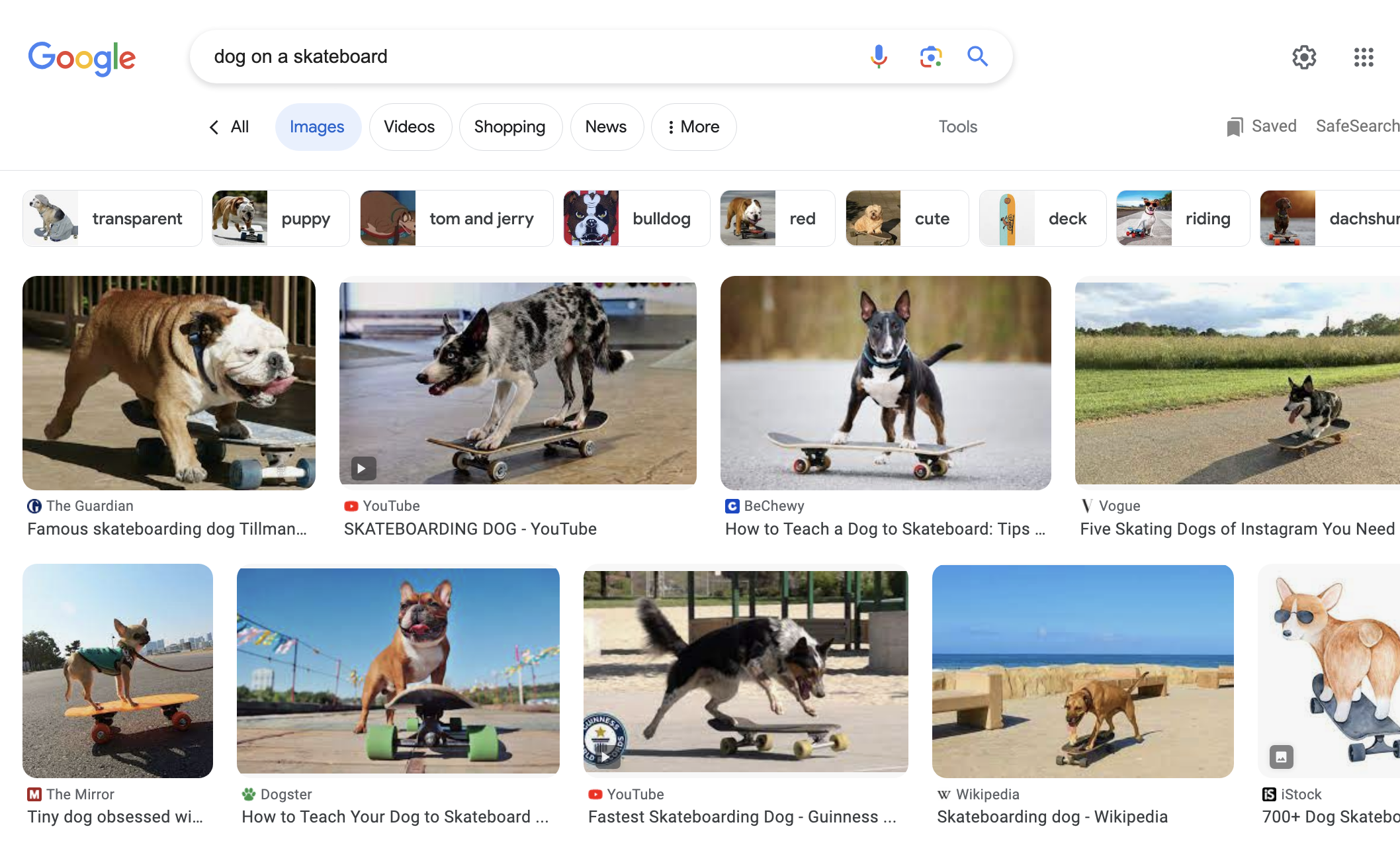 Screenshot from search for [dog on a skateboard], Google, August 2023
Screenshot from search for [dog on a skateboard], Google, August 2023
Entities can also be very helpful in optimizing images.
Google has worked very hard to analyze images using machine learning. So typically, Google knows the main imagery in most photos.
So take [a dog on a skateboard] as a search term…making sure that your content fully supports the image can help your content be more visible, just when the user is searching for it.
Entities In Google Discover
One of the most underrated traffic sources for SEO professionals is Google Discover.
Google provides a feed of interesting pages for users, even when they are not actively looking for something.
This happens on Android phones and also in the Google app on iPhones. Whilst news heavily influences this feed, non-news sites can get traffic from “Discover.”
How? Well – I believe that entities play a big factor!
 Screenshot from Google Search Console, August 2023
Screenshot from Google Search Console, August 2023
Don’t be disheartened if you do not see a “Discover” tab in your Google Search Console. But when you do, it can be a welcome sign that at least one of your web pages has aligned with entities enough that at least one person’s interests overlap with your content enough to have the page in a feed targeted specifically to the user.
In the example above, even though “Discover” results are not displayed at the exact time that a user is searching, there is still a 4.2% click-through rate.
This is because Google can align the interests and habits of many of its users to the content on the Internet by mapping entities.
Where a strong correlation occurs, Google can offer up a page for a user.
How To Optimize For Entities
Some Research From A Googler
In 2014, a paper came out that I find quite helpful in demonstrating that Google (or at least, its researchers) were keen to separate out the ideas of using keywords to understand topics vs. using entities.
In this paper, Dunietz and Gillick note how NLP systems moved towards entity-based processing. They highlight how a binary “salience” system can be used on large data sets to define the entities in a document (webpage).
A “binary scoring system” suggests that Google might decide that a document either IS or ISN’T about any given entity.
Later clues suggest that “salience” is now measured by Google on a sliding scale from 0 to 1 (for example, the scoring given in its NLP API).
Even so, I find this paper really helpful in seeing where Google’s research thinks “entities” should appear on a page to “count” as being salient.
I recommend reading the paper for serious research, but they list how they classified “salience as a study of ‘New York Times’ articles.”
Specifically, they cited:
1st-loc
This was the first sentence in which a mention of an entity first appears.
The suggestion is that mentioning the entity early in your web page might increase the chances of an entity being seen as “salient” to the article.
Head-count
This is basically the number of times the “head” word of the entity’s first mention appears.
“Head word” is not specifically defined in the article, but I take it to mean the word concatenated to its simplest form.
Mentions
This refers not just to the words/labels of the entity, but also to other factors, such as referrals of the entity (he/she/it)
Headline
Where when an entity appears in a headline.
Head-lex
Described as the “lowercased head word of the first mention.”
Entity Centrality
The paper also talks about using a variation of PageRank – where they switched out web pages for Freebase articles!
The example they shared was a Senate floor debate involving FEMA, the Republican Party, (President) Obama, and a Republican senator.
After applying a PageRank-like iterative algorithm to these entities and their proximity to each other in the knowledge graph, they were able to change the weightings of the importance of those entities in the document.
Putting These Entity Signals Together In SEO
Without being specific to Google, here, an algorithm would create values for all the above variables for every entity that an NLP or named entity extraction program (NEEP) finds on a page of text (or, for that matter, all the entities recognized in an image).
Then a weighting would be applied to each variable to give a score. In the paper discussed, this score turns into a 1 or 0 (salient or not salient), but a value from 0-1 is more likely.
Google will never share the details of those weightings, but what the paper also shows is that the weightings are determined only after hundreds of millions of pages are “read.”
This is the nature of large language learning models.
But here are some top tips for SEO pros who want to rank content around two or more entities. Returning to the example “restaurants near the Eiffel Tower”:
- Decide on a “dead” term for each entity. I might choose “restaurant,” “Eiffel Tower,” and “distance” because distance has a valid meaning and article in Wikipedia. Cafe might be a suitable synonym for restaurant, as might “restaurants” in the plural.
- Aim to have all three entities in the header and first sentence. For example: “Restaurants a small distance from the Eiffel Tower.”
- Aim in the text to talk about the inter-relationship between these entities. For example: “The Jules-Verne restaurant is literally inside it.” Assuming “it” clearly refers to the Eiffel Tower in the context of the writing, it does not need to be written out every time. Keep the language natural.
Is This Enough For Entity SEO?
No. Probably not. (You are welcome to read my book!) However, not all factors are in your control as a writer or website owner.
Two ideas that do seem to have an impact, though, are linking content from other pages in context and adding schema to help with the definitions.
Using Schema To Help Define Entities
Further clarity might be given to search engines by using the “about” and “mentions” schema to help a search engine disambiguate content.
These two schema types help to describe what a page is talking about.
By making a page “about” one or two entities and “mentions” of maybe a few more, an SEO professional can quickly summarize a long piece of content into its key areas in a way that is ready-made for knowledge graphs to consume.
It should be noted, though, that Google has not expressly stated one way or another whether it uses this schema in its core algorithms.
I would probably add this schema to my article:
<script type=”application/ld+json”> {
“@context”: “https://schema.org”,
“@type”: “WebPage”,
“@id”: “https://www.yoursite.com/yourURL#ContentSchema”,
“headline”: “Restaurants a small distance from the Eiffel Tower”,
“url”: “https://www.yoursite.com/yourURL”,
“about”: [
{“@type”: “Thing”, “name”: “Restaurant”, “sameAs”: “https://en.wikipedia.org/wiki/Restaurant”},
{“@type”: “Place”, “name”: “Eiffel Tower”, “sameAs”: “https://en.wikipedia.org/wiki/Eiffel_Tower”}
],
“mentions”: [
{“@type”: “Thing”, “name”: “distance”, “sameAs”: “https://en.wikipedia.org/wiki/Distance”},
{“@type”: “Place”, “name”: “Paris”, “sameAs”: “https://en.wikipedia.org/wiki/Paris”}
]
} </script>
The exact choice of schema is as much a philosophical question as an SEO question.
But think of the schema you use as “disambiguating” your content rather than “optimizing your content,” and you will hopefully end up with more targeted search traffic.
Editor’s note: Dixon Jones is the author of Entity SEO: Moving from Strings to Things.
More resources:
- Ranked Entities in Search Results at Google
- Patent Reveals How Google May Interpret Queries Based On Entity Information
- How Search Engines Work
Featured Image: optimarc/Shutterstock
Interactive Content: 10 Types To Engage Your Audience
Understand interactive content, and why it is so important, and how you can create 10 types that can improve your user experience.
 Julia Taylor
9.9K Reads
Julia Taylor
9.9K Reads

With people online more than ever before, interactive content marketing is your best bet to boost engagement and grow your audience.
Many savvy businesses have a content marketing strategy, so it’s important to think of ways to make your content stand out from your competitors.
Let’s explore different ways you can turn static content into interactive posts and pages that will encourage your audience to stay engaged.
But first, let’s understand a bit more about interactive content and why it is so important.
What Is Interactive Content Marketing?
Interactive content means content that prompts your audience to participate in some way, rather than simply consuming the information passively.
It doesn’t necessarily need to be anything fancy, it could be as simple as clicking a button, or answering a poll.
This type of content can make the experience more fun for your audience, and therefore make you and your brand more memorable.
Plus, it’s also a great way to get to know your audience better and collect important data.
Here’s a recent example we’ve implemented in my business.
For about one year, I’ve been asking my community what new skills they would like to learn. I’ve done that in different ways and in different platforms – on our private Facebook group, on Instagram Stories, on social posts, and on YouTube.
Those questions have both generated more engagement and given me solid data to decide what to do next.
Why Is Engaging Your Audience Important?
From the content they consume to the products they buy, people have more options (and more information) than ever before – and this can make gaining their attention quite difficult.
With a highly competitive market, it’s more important than ever to learn the best ways to engage an audience and keep them connected with your brand.
Interactive content marketing is more effective than other types of content not only because it boosts engagement (which we know all algorithms love), but also because it keeps people’s eyes on your brand for longer.
How Do You Measure Interactive Posts
You may be wondering what makes a post successful.
When you start testing different types of content, it’s important to keep an eye on these metrics:
Social Media Metrics
- Comments.
- Saves.
- Shares.
- Direct messages.
- Likes.
- Traffic to links.
Most social platforms provide business and creator accounts access to analytics, and you’ll find some of this information there.
If you’re running a promotional campaign or giving your audience a link to click on, it may be useful to leverage link tracking so you know where your traffic comes from.
You can use Google Analytics to track those links, and we also use the WordPress plugin, Pretty Links, to make them less overwhelming.
Web Page Metrics
- Session time.
- Sign-ups & leads.
- Conversion rate.
- Backlinks.
10 Different Types Of Content To Boost Engagement
There are different ways to create interactive content, and my best advice for you is to pick a couple and start testing.
Try different things until you have enough data to decide which type of content your audience responds best to – and then keep creating more of that.
1. Live Videos And Q&As
Videos are truly taking over the internet – which has made it one of the most effective types of marketing.
Live video content can be scary at first, especially if you’re an introvert like me. But it does get easier with time, and it’s totally worth it!
Live content allows you to hang out with your community, get to know them better, and help them get to know you and your brand!
This personal element and interaction can make a huge difference.
2. Create Polls, Multiple Choice Questions, And Quizzes
Polls and multiple-choice questions are super easy for people to interact with, and are super easy to create.
They’re also incredibly engaging. Why? Because people love to share their own thoughts and opinions on topics, and contribute to the conversation!
You can use polls and questions on Instagram Stories and Facebook groups, or if you have a YouTube channel with more than 500 subscribers, you can also create polls on your YouTube Community tab.
People also love quizzes! They’re an effective way to spark interest and get people’s attention.
They are also shareable, so they can become a great lead-generation tool. You can use online tools such as Typeform or Paperform to create your quiz.
3. Let Your Audience Rate Your Content
Another great way to engage your audience with your content is to allow them to rate your content. You can add rating widgets to your blog posts and/or website pages.
Showing the rating results on your website can increase your credibility and help you create content that people are interested in.
4. User-Generated Content (UGC)
Testimonials and reviews are so important for a reason. Let your clients or customers speak for you!
Word of mouth is one of the most powerful tools in marketing, and even though it may happen naturally, there’s no reason why you can’t incentivize your audience to get involved.
For example, you can create shareable content (such as a meme) and have a call to action to share, tag, or send to a friend who can relate.
You can also give your current customers an incentive to share about you and your brand with a customizable story template or a giveaway, for example.
5. Gamification
Who doesn’t love a good game?
From simple word searches to sophisticated online games – gamification is a great way to engage your audience.
Big companies have had great success with such campaigns, and there’s no reason why you can’t scale them down and make them work for your audience.
6. Animations
Animations go a long way to catch people’s attention – so try adding some movement to your content!
You can do that with GIFs, hover effects, or even dynamic scrolling (where items move as the user scrolls through the page).
Especially on sales pages, when you usually have a lot of information to include, animations can help keep people interested – and maybe even improve your conversion rate.
And now, building HTML/CSS animations is even easier with ChatGPT – you can simply ask it to build one for you!
For example, you can run the below prompt and use the codes generated.
<<HTML/CSS and javascript animation to fade in text when it enters into a browser viewport>>7. Infographics
Big chunks of text can often look overwhelming and this might be a turn-off for readers.
If you have a lot you want to communicate, the best way to do this is by creating an infographic.
They combine aesthetically pleasing design with important information – and often, people are more likely to read them than generic text.
8. Giveaways
Giveaways are a great marketing technique, as they pique people’s attention and encourage them to engage with your brand.
You can offer incentives for people to share the content, tag friends, or even encourage your audience to show up to live events.
If you can generate more shares of your content, this can also become a great lead generation tool, as you’ll reach more people who may not have heard of your brand.
And the prize could be a product or service you offer, or even gift cards from Amazon and Starbucks, for example.
9. Tabs & Carousels
Another way to break up text-heavy content is by using tabs and carousels.
Giving users an option to choose what they want to see. It also helps keep the content organized and easy to find.
Instead of having to scroll through long pages, they can easily click and find what they’re looking for.
It also adds more interactivity to your content, which can be far more interesting than just reading big blocks of text.
10. Repurposed Content
Creating content is very time-consuming and can be exhausting. So don’t be afraid of repurposing content.
Marketing is about repetition, it’s about finding different ways to transmit your message and reach the right people.
If you have a post that received tons of engagement, think of different ways you can share that again. Maybe you can create a quiz related to the topic, or even make some tweaks and share it again on a different platform.
Not only will you save time, but you’ll also create content more effectively, as you’ll be repurposing content you already know resonates with your audience.
Think YouTube videos, blog posts, and podcasts – longer forms of content can easily be repurposed into several small pieces of content.
Final Thoughts
As usual with marketing, there’s no one-size-fits-all recipe that’ll make your content stand out.
But interactivity is extremely important in the online world, and it will improve user experience.
Also important to note that your audience’s interests and expectations may change from time to time. What works well today may not be the best option one year from now.
Don’t be afraid of changing and testing as you go; that’s the best way to learn more about your target audience.
More resources:
- 8 Engaging Infographic Types & How To Create Them (+ 5 Free Tools)
- Content Marketing Metrics & Analytics: 5 Types Of Data Insights
- Content Marketing: The Ultimate Beginner’s Guide
Featured Image: Interactive Content/Shutterstock
How To Maintain Brand Visibility And Thrive As Search Evolves
Maximize brand visibility in the changing search landscape. Learn strategies to maintain control of your content on AI-powered platforms.
 Martha van Berkel
2.2K Reads
Martha van Berkel
2.2K Reads

As of July 2024, ChatGPT had approximately 2.9 billion monthly visits, compared to Google’s 130.1 billion, Facebook’s 13.2 Billion, X’s 4.1 billion, and Amazon’s 3.2 billion.
While ChatGPT’s monthly visits might seem like peanuts in comparison, it has built a strong user base in months and will likely continue to dominate as AI search gains popularity.
Similarly, we’re seeing these major search engines and social media platforms incorporate generative AI into the user experience.
What does this mean for your customers and prospects? Consumers can use new and existing platforms to interact with your content in a more natural conversation style.
They can ask questions, build on ideas, and get answers without leaving the interface.
So, how can brands maintain their visibility on these platforms and control how their content is understood in the face of generative AI? The answer boils down to three things:
- Investing in great content.
- Developing a content knowledge graph.
- Having a growth mindset.
Together, these three pillars will ensure that people and machines understand your brand and content, enabling your team to thrive in this new world of generative AI search.
Let’s start with content.
Investing In Great Content
Over the last two years, we’ve seen Google place heavy emphasis on “Helpful, reliable, people-first content.”
This means creating helpful, reliable content that focuses primarily on your audience’s needs – not the search engines.
While this seems logical, it’s a big shift from the old way of developing website content for search engines.
Your content should seek to provide a comprehensive answer to your audience’s questions, address any additional information they might need to know, and demonstrate your brand’s first-hand expertise or experience in the topic.
I love how people-first content brings us back to content as a service. Your content answers questions, helps make decisions, points people in the right direction, and delights them.
For brands to thrive in this new age of AI, they must continue to invest in great content. This requires your team to take the time to understand your audience and their changing needs, find gaps in your current content strategy, and iterate on existing content to continue delighting your audience.
Apart from investing and evolving your website content to delight your audience, you must also ensure that search engines, AI, and other machines can easily understand your content and infer answers from your data.
You can do this by implementing advanced schema markup on your site to develop a content knowledge graph.
Developing A Content Knowledge Graph
Earlier this year, Gartner published its research on the 30 Emerging Technologies That Will Guide Your Business Decisions in 2024.
It identified generative AI and knowledge graphs as two emerging technologies organizations should start investing in to be ready to utilize when they mature. While generative AI has gained widespread popularity through its productivity potential, knowledge graphs remain less well-known.
A knowledge graph is a collection of relationships between things defined using a standardized vocabulary, from which new knowledge can be gained through inferencing.
In fact, Google and Microsoft have been using knowledge graphs to generate knowledge panels and infer answers in search since 2010.
Many research papers, including the article Unifying Large Language Models and Knowledge Graphs: A Roadmap, explain that knowledge graphs “can enhance LLMs by providing external knowledge for inference and interpretability.” Hence reducing the risk of hallucinations in LLMs.
Content knowledge graphs, similar to a knowledge graph, are collections of relationships between entities on your website. Many digital marketing organizations have invested in building content knowledge graphs for their web data by implementing advanced schema markup (aka structured data).
Schema markup, also known as structured data, is machine-readable data that helps search engines understand the content on a page and show the content as a rich result on the search engine result page. However, the value of schema markup goes beyond that.
Your website content is filled with entities about your business – for example, your location, your employees, your products, etc.
When you describe the entities on your page and define their relationship with other entities in your business and things in the world using schema markup, you’ve effectively created a content knowledge graph.
Your content knowledge graph, filled with factual data based on your website content, can help AI and search engines infer things about your brand and provide users with accurate answers to their queries.
It can also help your content team identify areas where content is lacking or could be improved, thus supporting your content strategy.
Having A Growth Mindset
The third pillar to thriving in this new world of AI and search is the mindset of your team.
The marketing industry is experiencing unprecedented speed of change, propelled by AI.
As AI technology grows exponentially more powerful, those who don’t keep up will have to play catch up and potentially lose out to competition.
Therefore, teams that want to thrive must keep their learning hats on at all times and be ready to adapt and embrace innovation.
Furthermore, silos within organizations must be busted.
Take the two capabilities I mentioned earlier: schema markup and content knowledge graphs. Their success depends on the cross-functional work across marketing, SEO, IT, digital, and support.
Together, these teams will need to try something new, measure what they can, see if it drives the business’s desired outcomes, and then iterate on what they’ve learned.
At Schema App, we say that we are either “winning or learning,” and this is what I view as having a growth mindset.
In the Harvard Business Review article, What Having a Growth Mindset Really Means, author Carol Dweck defined having a growth mindset as:
“[individuals] who believe their talents can be developed (through hard work, good strategies, and input from others)… they worry less about looking smart and put more energy into learning.”
Organizations that fully embrace the growth mindset also see greater collaboration and innovation.
In Summary
As the world of AI and search continues to evolve, there are things you can do now, like invest in content and develop a content knowledge graph to control how AI and search engines understand your brand and content.
However, fostering collaboration and innovation within your team is the key to thriving in this ever-changing world of AI and search.
When your team embraces a growth mindset, no matter the changes disrupting search, content, or AI, you’ll be ready.
More resources:
- Just How Important Is Structured Data In SEO?
- How To Maximize Your Reach Using Google’s Knowledge Graph
- Entities In SEO: What Are They And Why Do They Matter?
Featured Image: Gracia Chua/Schema App

 2 months ago
8
2 months ago
8




















 English (US) ·
English (US) ·